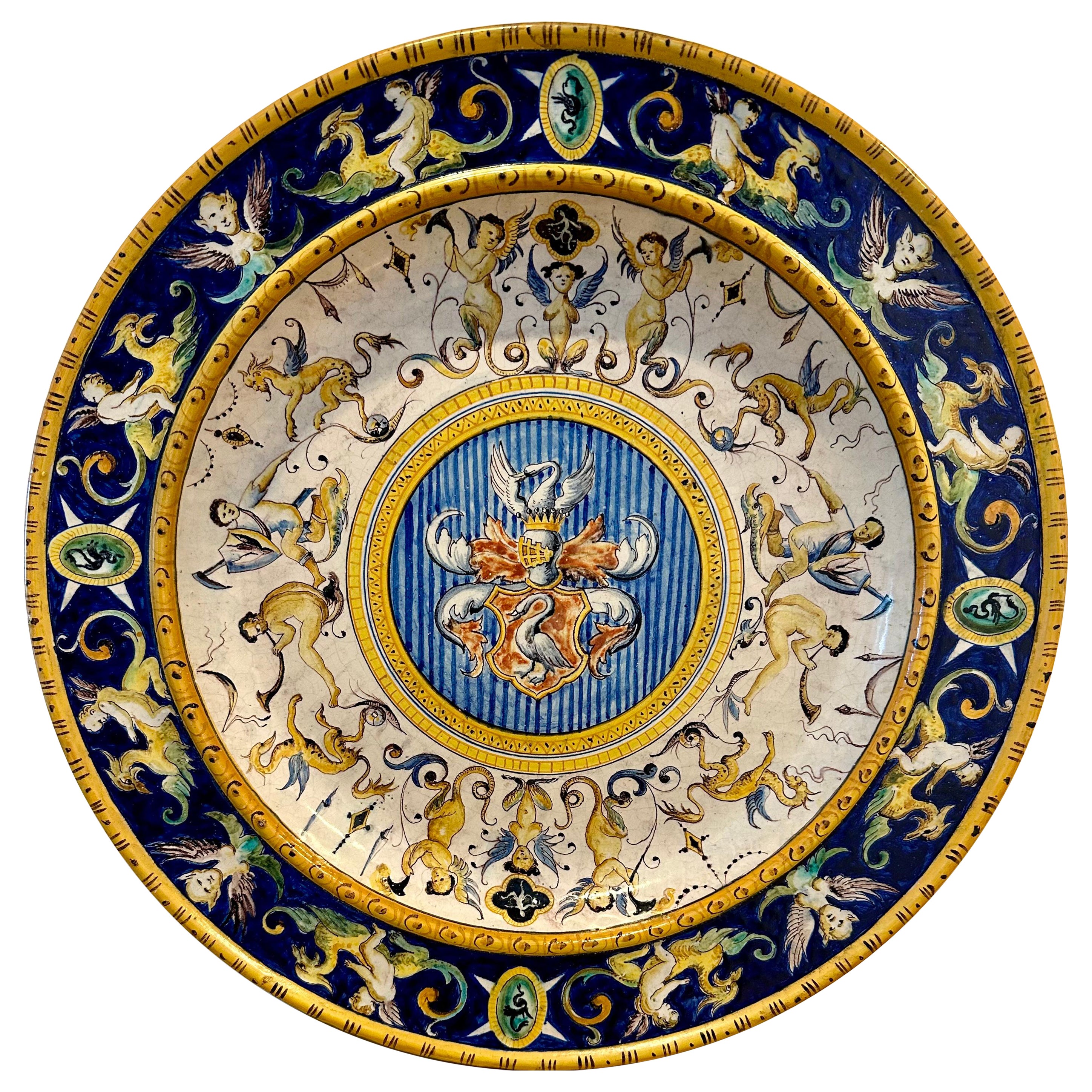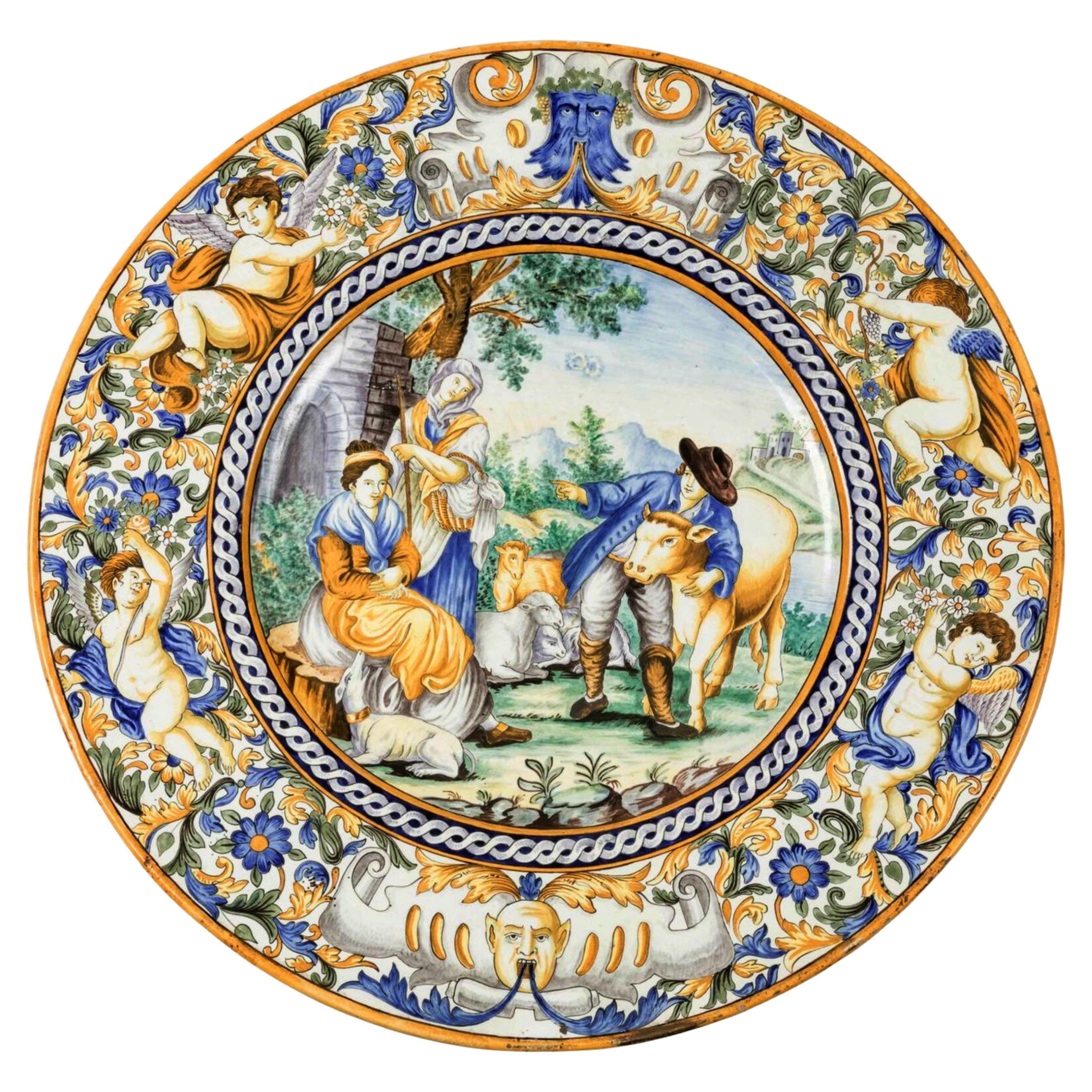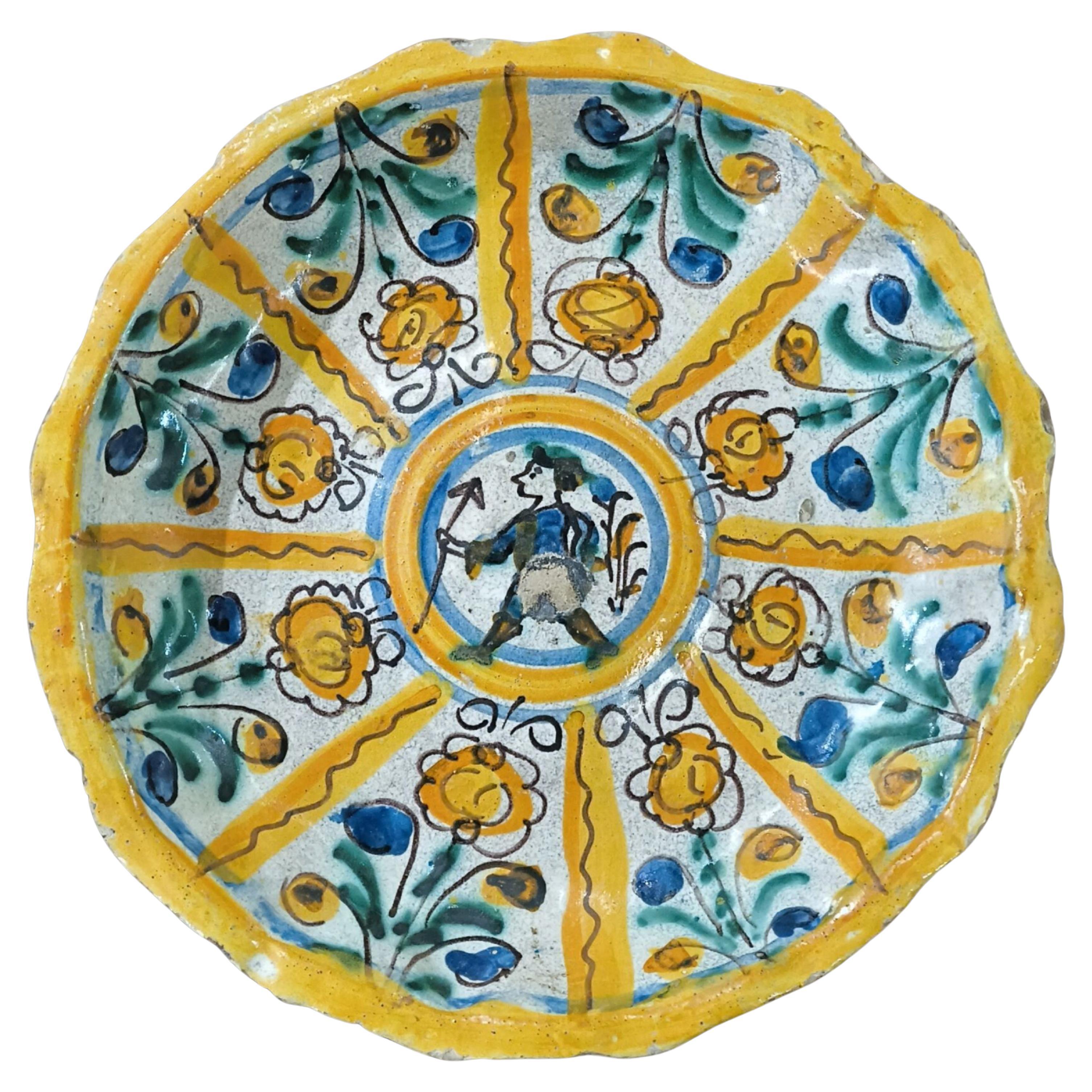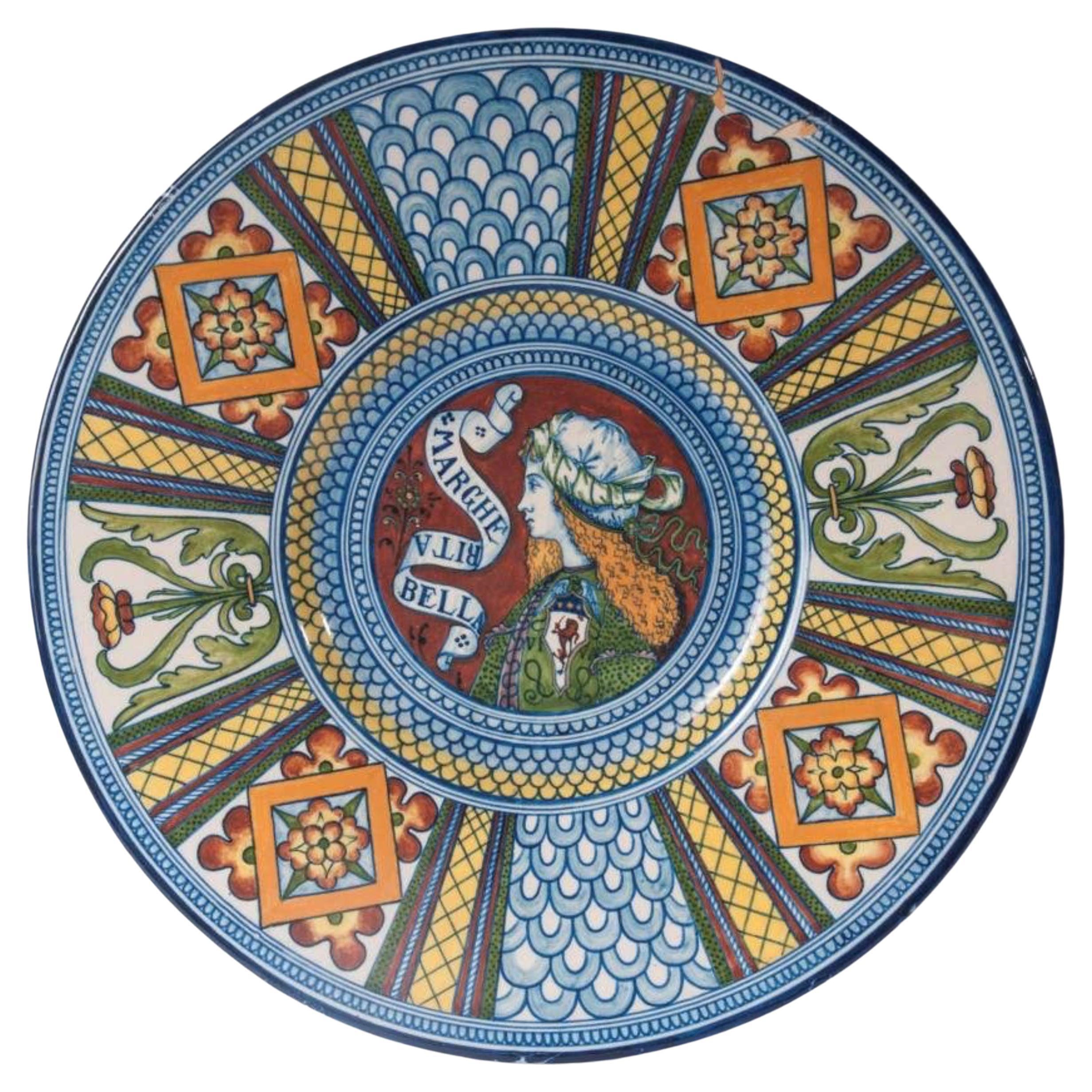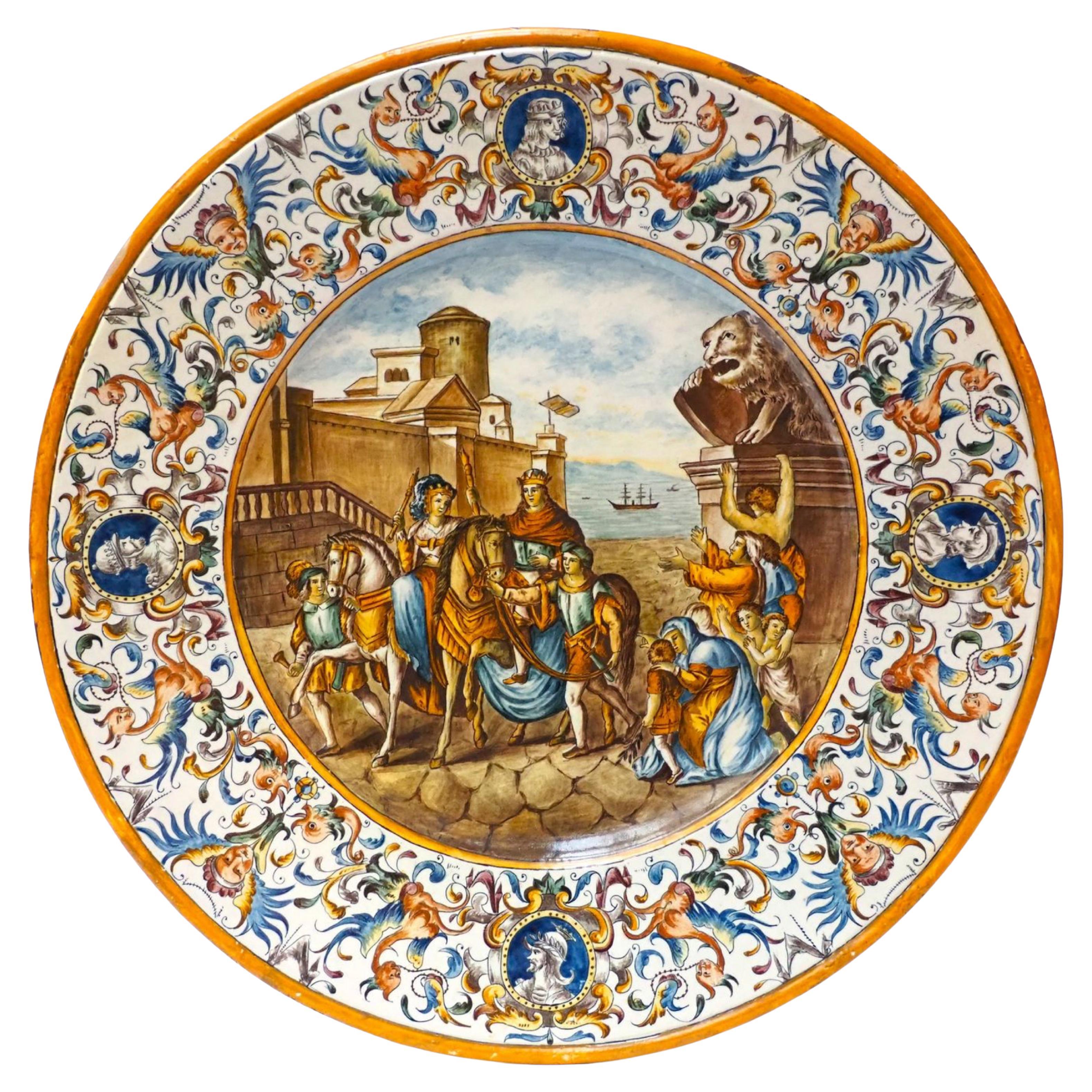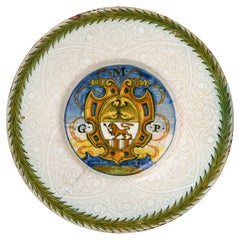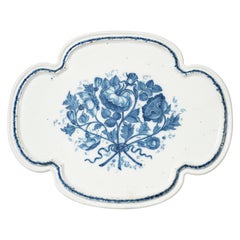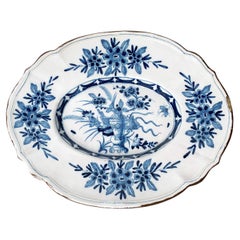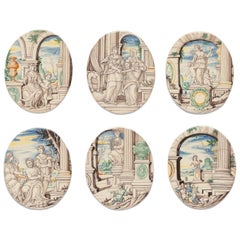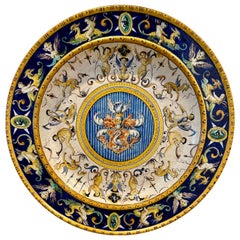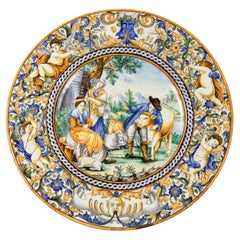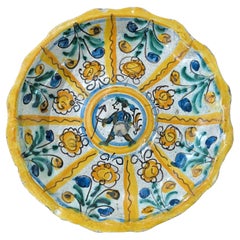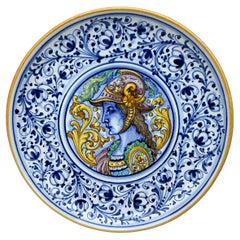Items Similar to Italian Renaissance Plate, Patanazzi Workshop Urbino, End of 16th Century
Video Loading
Want more images or videos?
Request additional images or videos from the seller
1 of 20
Italian Renaissance Plate, Patanazzi Workshop Urbino, End of 16th Century
$29,639.89
£22,182.26
€25,000
CA$40,890.81
A$45,472.28
CHF 23,883.03
MX$555,944.23
NOK 297,605.39
SEK 280,561.50
DKK 190,312.42
About the Item
Acquareccia plate
Patanazzi workshop
Urbino, last quarter of the 16th century
It measures diameter 17.12 in; foot diameter 11.53 in; height 1.88 in (43.5 cm; 29.3 cm; 4.8 cm).
Weight
State of conservation: wear and a few small minimal detachments of enamel, chipping on the raised areas, peeling of enamel at the brim on the back.
This large, shallow basin is equipped with a wide and convex well. It is umbonate with a contoured center. The brim, short and flat, is enclosed in a double rounded and barely raised edge. The basin has a flat base without rims; it has a slightly concave center in correspondence to the well.
The shape takes inspiration from the basins associated with the metal forged amphora pourers that traditionally adorned the credenza. These were used from the Middle Ages to wash hands during banquets. Two or three people washed their hands in the same basin and it was considered an honor to wash one’s hands with an illustrious person.
The decoration is arranged in concentric bands with, in the center of the umbo, an unidentified shield on a blue background: an oval banded in gold with a blue head, a gold star and a field with a burning pitcher.
Rings of faux pods separate the center from a series of grotesque motifs of small birds and masks. These go around the basin and are, in fact, faithfully repeated on the brim. The main decoration develops inside the flounce of the basin, which sees alternating symmetrical figures of winged harpies and chimeras. The ornamentation, outlined in orange, green and blue, stands out against the white enamel background.
This decorative style, defined since the Renaissance as “grottesche” or “raffaellesche”, refers to the decorations introduced after the discovery of the paintings of the Domus Aurea towards the end of the fifteenth century. The discovery of Nero's palace, buried inside Colle Oppio by damnatio memoriae, occurred by chance when a young Roman, in 1480, fell into a large crack which had opened in the ground on the hill, thus finding himself in a cave with walls covered with painted figures.
The great artists present in the papal city, including Pinturicchio, Ghirlandaio, Raffaello, immediately visited these caves. The decorations found there soon became a decorative subject of immense success: the term grotesque , with the meaning of “unusual,” “caricatured,” or “monstrous,” was later commented by Vasari in 1550 as “una spezie di pittura licenziose e ridicole molto”( “a very licentious and ridiculous kind of painting”).
The decorations “a grottesche” also widely circulated in ceramic factories, through the use of engravings, variously interpreted according to the creativity of the artists or the requests of the client.
Our basin is reflected in similar artifacts produced at the end of the sixteenth century by the factories of the Urbino district. See the series of basins preserved in the main French museums, among which the closest in morphology is that of the Campana collection of the Louvre (Inv. OA1496); this however has a more complex figure decoration, while the decoration of our specimen is sober and with a watercolor style.
The style, sure in its execution, approaches decorative results still close to the works produced around the middle of the sixteenth century by the Fontana workshop. The decoration is closely linked to their taste, which later finds its natural outlet, through the work of Antonio, also in the Patanazzi workshop. Studies show the contiguity between the two workshops due to the kinship and collaboration between the masters Orazio Fontana and Antonio Patanazzi, both trained in the workshop of Guido Fontana il Durantino. It is therefore almost natural that their works, often created according to similar typologies and under the aegis of the same commissions, are not always easily distinguishable, so much so that the presence of historiated or “grottesche” works by Orazio is documented and preserved in Antonio Patanazzi's workshop. Given that the studies have always emphasized the collaboration between several hands in the context of the shops, it is known that the most ancient “grottesche” works thus far known, can be dated from 1560, when the Fontana shop created the so-called Servizio Spagnolo (Spanish Service) and how, from that moment on, this ornamentation became one of the most requested by high-ranking clients. We remember the works created for the Granduchi di Toscana, when Flaminio Fontana along with his uncle Orazio supplied ceramics to Florence, and, later, other commissions of considerable importance: those for the service of the Duchi d’Este or for the Messina Farmacia of Roccavaldina, associated with the Patanazzi workshop when, now after 1580, Antonio Patanazzi began to sign his own work.
Thus, in our basin, the presence of masks hanging from garlands, a theme of more ancient memory, is associated in the work with more advanced stylistic motifs, such as the hatching of the chimeras and harpies. These are found here on the front with the wings painted in two ornate ways. In addition, the theme of the birds on the edge completes the decoration along the thin brim and can be seen as representing an early style typical of the Urbino district during a period of activity and collaboration between the two workshops. Later, a more “doll-like” decorative choice, typical of the end of the century and the beginning of the seventeenth century, characterized the period of the Patanazzi workshop under the direction of Francesco.
Bibliography:
Philippe Morel, Il funzionamento simbolico e la critica delle grottesche nella seconda metà del Cinquecento, in: Marcello Fagiolo, (a cura di), Roma e l'antico nell'arte e nella cultura del Cinquecento, Roma, Istituto della Enciclopedia Italiana, 1985, pagg. 149 -178.
Marco Spallanzani, Maioliche di Urbino nelle collezioni di Cosimo I, del cardinale Ferdinando e di Francesco I de’ Medici, “Faenza” 1979, IV, pp.115-116.
Franco Negroni, Una famiglia di ceramisti Urbinati: i Patanazzi, “Faenza”, LXXXIV, 1998, 1-3, p. 104-115.
Carola Fiocco - Gherardi Gabriella, I Patanazzi: alla ricerca di Antonio; la scodella del Maldonado, in "Faenza", bollettino del Museo internazionale delle ceramiche in Faenza, XCV, 2009, 1-6, p. 64.
- Attributed to:Patanazzi Workshop (Maker)
- Dimensions:Height: 1.89 in (4.8 cm)Diameter: 17.13 in (43.5 cm)
- Style:Renaissance (Of the Period)
- Materials and Techniques:Maiolica,Glazed
- Place of Origin:
- Period:
- Date of Manufacture:Circa 1580-1590
- Condition:Minor losses. Wear and a few small minimal detachments of enamel, chipping on the raised areas, peeling of enamel at the brim on the back.
- Seller Location:Milano, IT
- Reference Number:1stDibs: LU4352231035512
About the Seller
4.3
Vetted Professional Seller
Every seller passes strict standards for authenticity and reliability
Established in 1860
1stDibs seller since 2018
21 sales on 1stDibs
Associations
International Confederation of Art and Antique Dealers' Associations
- ShippingRetrieving quote...Shipping from: Milano, Italy
- Return Policy
Authenticity Guarantee
In the unlikely event there’s an issue with an item’s authenticity, contact us within 1 year for a full refund. DetailsMoney-Back Guarantee
If your item is not as described, is damaged in transit, or does not arrive, contact us within 7 days for a full refund. Details24-Hour Cancellation
You have a 24-hour grace period in which to reconsider your purchase, with no questions asked.Vetted Professional Sellers
Our world-class sellers must adhere to strict standards for service and quality, maintaining the integrity of our listings.Price-Match Guarantee
If you find that a seller listed the same item for a lower price elsewhere, we’ll match it.Trusted Global Delivery
Our best-in-class carrier network provides specialized shipping options worldwide, including custom delivery.More From This Seller
View AllSmall Maiolica Plate, Urbino District, 1533-1555
Located in Milano, IT
Maiolica plate (tondino)
Urbino district, Casteldurante or Pesaro, 1533-1555
It measures: diam. 7.48 in (19 cm), foot diam. 2.75 in (7 cm), height 1.0...
Category
Antique 16th Century Italian Renaissance Ceramics
Materials
Maiolica
18th Century Italian Maiolica Centerpiece Bassano Venice, circa 1750
Located in Milano, IT
Maiolica centerpiece
Pasquale Antonibon factory
Nove di Bassano, Venice, 1740-1770.
Measures: 1.85 in x 19.21 in x 15.27 in
4.7 cm X 48.8 cm X 38.8 cm.
lb 5.29 (kg 2.4)
State of conservation: thin passing fêlure with covered chipping and a glued foot
The Antonibon were an important family of Venetian...
Category
Antique 1750s Italian Baroque Ceramics
Materials
Maiolica
Maiolica Oval Tray, Felice Clerici Manufactory, Milan, Circa 1770-1780
By Felice Clerici
Located in Milano, IT
Small oval tray
Felice Clerici Manufactory 1745-1780
Milan, Circa 1770-1780
Maiolica polychrome.
Dimensions: 10.82 x 8.66 in (27.5 x 22 cm); weight 0.4...
Category
Antique 1770s Italian Rococo Ceramics
Materials
Maiolica
Ancient Maiolica Tiles, Ambrogette, Rampini Manufactory, Pavia, 1693-1704
By Siro Antonio Africa
Located in Milano, IT
Six maiolica “ambrogette” (tiles)
Rampini manufactory, painter probably Siro Antonio Africa
Pavia, 1693-1704
a) 6.88 x 5.51 in (17.5 x 14 cm); 0.55 lb (252 g)
b) 7.08 x 5.70 in (18 x 14.5 cm); 0.51 lb (233 g)
c) 6.88 x 5.70 in (17.5 x 14.5 cm); 0.54 lb (245 g)
d) 6.81 x 5.51 in (17.3 x 14 cm); 0.50 lb (230 g)
e) 6.88 x 5.51 in (17.5 x 14 cm); 0.50 lb (229 g)
f) 7.08 x 5.70 in (18 x 14.5 cm); 0.51 lb (233 g)
State of conservation: intact.
These six ”maiolica fina” small “ambrogette” belong to a family of ceramic works considered among the finest produced between the 17th and 18th centuries. For a long time, this type of maiolica was attributed to the Venetian village of Angarano, but later it was definitively attributed to the pottery factories in Pavia. A fundamental study ascribed this production specifically to Pavia through an analysis of Lombard collections and a comparison with archaeological remains found near the two main manufacturing sites in the city. (E. Pelizzoni - M. Forni - S. Nepoti, La maiolica di Pavia tra Seicento e Settecento, Milano 1997).
The six small oval tiles have rounded edges and are decorated with a historiated motif. They were created using high-fired polychrome technique, with a predominance of cool tones and a dominance of gray and blue, interspersed with manganese, citrine yellow, orange-yellow, and green. The six small “ambrogette” are characterized by the same stylistic features, with a similar decorative design.
The first tile (a) depicts a female figure, holding a stiletto and sitting near a pedestal supporting a relief-decorated baluster vase. Behind her, a child is holding a chalice, while through the arches of a portico, a glimpse of a mountainous landscape can be seen in the background. The female figure could possibly be Lucretia, an example of virtue in ancient Roman culture.
In the second “ambrogetta” b), the Biblical episode of Judith and Holofernes is depicted through canonical iconography: the decapitated body of Holofernes lies on the bed in the background, while the protagonist, Judith, is seen placing his head into a sack held by a maidservant. Through an archway a shining slice of the moon gives the perception of nighttime. Surprisingly, within the narrative, there is the presence of a basin in the shape of a large shell, closely resembling the products of Pavia's factories.
The third small plaque (c) depicts a female figure standing on a plinth and framed by an architectural arch with a vast mountainous landscape in the background. The woman, with her breasts exposed, is accompanied by two children: one approaching her as if wanting to be picked up, and the other seated with an apple in his hand. The protagonist lends herself to different interpretations: perhaps she represents Rea Silvia with the two twin founders of Rome, or perhaps she is an allegory for the Pietà, a common theme depicted on maiolica.
In the fourth tile (d), three characters are depicted near a column. The main figure is an old man with a sad expression, holding a cup, while a woman, wearing a turban on her head, also holds a cup in her right hand and a pitcher in her left. A second woman with her hair bound holds another pitcher behind the old man: at his feet a traveller's bag can be seen, along with some apples and a slice of cheese on a rectangular base. It is likely the sad Biblical episode of Lot and his daughters...
Category
Antique Early 1700s Italian Baroque Ceramics
Materials
Maiolica
Ancient Maiolica Plates Pasquale Rubati, Milan Circa 1770-1780
By Pasquale Rubati
Located in Milano, IT
Five oval maiolica dishes with pierced edge
Manufacture of Pasquale Rubati
Milan, 1770-1780
Three small oval dishes 10.23 in x 7.67 in (26 cm x 19.5 cm)
Two large oval dishes 10.82 in x 8.85 in (27.5 x 22.5 cm)
lb 3.5 (kg 1.8)
State of conservation: intact
The five dishes of different sizes have an oval shape, a mixtilinear edge and a molded polylobed shape with a surface enriched with a relief weave motif extending to the brim and forming a perforated basket...
Category
Antique 1770s Italian Rococo Ceramics
Materials
Maiolica
Ancient Italian Maiolica Faenza, Ferniani Factory, Circa 1700
By Ferniani Factory
Located in Milano, IT
Centerpiece white maiolica shell
Ferniani factory, early period: 1693-1776
Faenza, circa 1700
Measures: 5.6 in x 14.72 in x 13.46 in (14.3 cm x 37.4...
Category
Antique Early 1700s Italian Baroque Ceramics
Materials
Maiolica
You May Also Like
Italian Cantagalli Maiolica Large Plate with family noble emblem, Late 19th C.
By Cantagalli
Located in CH
Italian Cantagalli Maiolica Large Plate with family noble emblem, Late 19th Century
During the 19th century Renaissance-Revival period the Cantagalli Maiolica and ceramic factory near Florence produced authentic copies of Renaissance Maiolica using traditional methods of tin glazing earthenware.
This large Maiolica plate from the late 1800s is marked on the back with the symbol of the Rooster, which indicates that it was created by the Cantagalli ceramics factory. The plate is decorated in the center with the noble emblem of the house of Frederick Stibbert, a well-known late 19th century English/Italian collector of ancient weapons...
Category
Antique Late 19th Century Italian Renaissance Revival Ceramics
Materials
Ceramic, Maiolica
Amazing CASTELLI Plate, Italy 19th Century D: 62cm
Located in Madrid, ES
Amazing CASTELLI Plate, Italy 19th Century D: 62cm
Large plate in glazed and polychrome majolica earthenware.
The basin shows a pastoral scene.
The edge is underlined by two orange...
Category
Antique 19th Century Italian Rococo Ceramics
Materials
Majolica
AMAZING PLATE MONTELUPO 17th Century
By FF Montelupo
Located in Madrid, ES
AMAZING PLATE MONTELUPO 17th Century
Round earthenware bowl with contours on a pedestal, polychrome decoration of a soldier in a frame of floral reserves.
Minor restorations.
Diame...
Category
Antique 17th Century Italian Baroque Decorative Art
Materials
Porcelain, Maiolica
Large Neo-Renaissance Italian Faience Platter Circa 1930
Located in Austin, TX
Large Neo-Renaissance Italian Faience Platter Circa 1930.
Category
Vintage 1930s English Renaissance Revival Platters and Serveware
Materials
Ceramic, Faience
Beautiful Massimo Popper Plate, 1911/1914, 20th Century
Located in Madrid, ES
Beautiful Massimo Popper Plate, 1911/1914, 20th Century
Pompous polychrome ceramic "Marguerite" with a wide brim, short frill, and wide base. The rim is decorated with metopes and t...
Category
Early 20th Century Italian Baroque Decorative Art
Materials
Maiolica, Porcelain
Gaetano BATTAGLIA (Naples-Italy-Active 1850 and 1885) Large Circular Plate
Located in Madrid, ES
Gaetano BATTAGLIA (Naples-Italy-Active between 1850 and 1885)
Large circular earthenware plate
in the style of Italian majolica with polychrome historiated decoration on the basin, t...
Category
Antique 19th Century Italian Rococo Ceramics
Materials
Majolica
More Ways To Browse
Italian Renaissance Plates
1p Italy
Artist Feller
Faenza Italian Ceramics
16th France Renaissance
Silver Enamel Figure
Double Rimmed Glasses
Italian Bird Plate
Glass Head Orange
Renaissance Style Ring
Spanish Shield
Blue And White Bird Plates
Antique Spanish Rings
Large White Pitchers
Orange Glass Pitcher
Orange Glass Birds
Ornate Silver Ring
Italian Ceramic Pitcher
